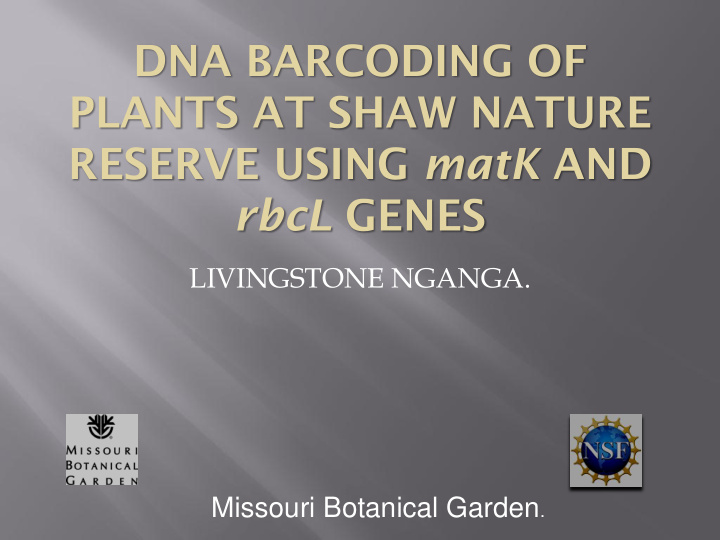



DNA BARCODING OF PLANTS AT SHAW NATURE RESERVE USING matK AND rbcL GENES LIVINGSTONE NGANGA. Missouri Botanical Garden .
Barcoding is the use of short DNA sequences to identify and differentiate species. The sequences are intraspecifically conserved but vary interspecifically.
Easy identification of species. Can be used to detect illegal trade of restricted animal parts or plants. Testing the authenticity of plant products. Complement taxonomy in difficult groups.
DNA barcodes should, Be short for easy PCR amplification. a) Be easily sequenced in both the forward and b) reverse direction. Have universal primers. c) Be conserved within species but variable d) among different species.
Plastid genes preferred In animals, the mitochondrial gene CO1 is used Several genes proposed for plants with the most prominent being atpF-atpH, matK, nhdJ, psbK-psbI, rbcL and trnH-psbK (all chloroplast genes) and ITS (a nuclear gene) Plastids are clonal and can give info such as hybridization events A combination of rbcL and matK was proposed as the plant barcode by CBOL
rbcL matK Entire gene ~1400bp Entire gene ~1550bp 1. 1. long long ~ 650 bp used for ~ 880 bp used for 2. 2. barcode barcode Can discriminate High species 3. 3. genera but not species discrimination Easily amplified Low amplification in 4. 4. some groups Over 20,000 species 5. sequences publicly ~22,000 species 5. available sequences publicly available
Test the effectiveness of the rbcL+matK as a barcode on plants at Shaw Nature Reserve. A glade in Shaw Nature Reserve. Photo credit: Livingstone Nganga.
About 30 miles from St. Louis Vegetation types include upland and bottomland forest, glades, tall grass praire, wetland, old graze lands and cultivated fields Includes 1053 plant species in 503 genera and 151 families
Echinacea paradoxa Oenothera macrocarpa Hydrangea arborescens. Matelea decipiens Melanthium virginicum Tripsacum dactyloides Rosa setigera Matelea decipiens Photo credit. David Bogler .
62 plants species collected and a few leaves cut and dried in silica DNA extracted from dried leaves rbcL (primers rbcLa_F /rbcLa_R ) and matK (primers KIM_F/KIM_R ) genes amplified PCR product run in 1% agarose gel electrophoresis at 72V Successful amplicons sequenced at Yale University DNA sequencing facility Sequences over 500 bp long were considered successful and were used to identify plant in the BOLD database (www.barcodinglife.com)
100 bp ladder ~700bp Direction of run
Identification using the BOLD
45 species amplified for rbcL and 38 species for matK and were sequenced 20 species had high sequence success (sequences 500 bp or higher) for both rbcL and matK 6 species identified with 100% match. The rest could only identify the genus with 98-99% match 10 identified the genus of the species although the species themselves were not on the database
RESULTS Feature rbcL matK PCR success 72.6% (45/62) 61.3% (38/62) Seq > 500 bp 46.7% (21/45) 68.4% (26/38) Seq >400bp 73.3% (33/45) 76.3% (29/38)
rbcL+matK barcode works well although cannot distinguish some of the plants species. Sequences for some plants are missing in the BOLD database. Sequences will have to be uploaded for barcoding to be possible.
I would like to thank : My mentor, David Bogler, Ph. D. Sandra Arango-Caro, Ph.D. George Yatskievych, Ph.D. Sharon Carter. NSF. Missouri Botanical gardens.
CBOL plant working group. 2009. A DNA barcode for land 1. plants. PNAS. 106. 12794-12797 Hollingsworth, P. M., S. W. Graham, and D. P. Little.2011. 2. Choosing and using a plant DNA barcode. PlosOne journal. 6. Issue 5. E19254 Ford, D.S, K.L Ayres, N. Toomey, N. Haider et al. 2009. 3. Selection of candidate coding DNA barcoding regions for use on land plants. Botanical Journal of the Linnean Society. 159, 1-11 Haider, N. Chloroplast-specific universal primers and their 4. uses in plants studies. 2011. Biologia Plantarum 55 (2). 225- 236. Vijayan, K. and C.H Tsou. DNA barcoding in plants: 5. taxonomy in a new perspective. Current Science. 99. Issue 11. 1530-1541.
Recommend
More recommend